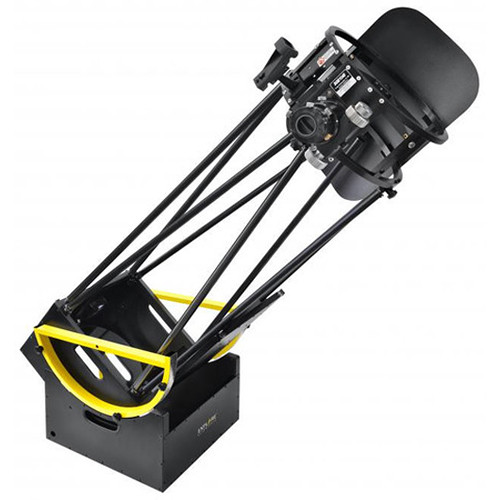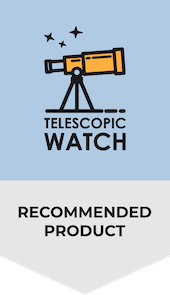What makes this scope different?
The main factor that makes this 10-inch Dobsonian different is that it is a truss telescope. In the past, telescopes and, for that matter, almost all commercial Dobsonians were what’s known as solid tube. A solid tube telescope is one where the tube that holds the mirrors is completely solid, typically metal or, in some cases, wood. A truss-style telescope is almost completely different, as it is constructed with truss poles. This means that there is no tube at all. How can that be? Won’t light spill into the telescope? I will answer that here, and also explain why it can be very advantageous.

A truss telescope consists of four major parts: the base/rocker box, the mirror box, the truss poles, and the upper tube assembly. The rocker box in a truss telescope is the part that contains the bearings to move the telescope up, down, left, and right, and it is what the telescope sits on. Because the truss telescope design has a much different centre of gravity, the rocker box can be very short.
Next is the mirror box, and it is, as the name implies, where the main mirror is located. The mirror box is typically very short as it does not do much more than hold the mirror in and collimate the mirror. The mirror box is where the altitude bearings attach, as they pivot up and down. The truss poles attach to the top of the mirror box.
The upper tube assembly sits on top of the truss poles, and it holds the secondary mirror, finderscope, and focuser of the telescope. Typically, the upper tube assembly is formed of two lightweight rings with struts in between, as you will find on this telescope. The upper tube assembly is also very light as it is almost completely hollow while still being quite strong.
The truss poles are the main feature in a telescope like this. Truss poles replace the typically very heavy metal tubes that become impractical for large telescopes, and they make the telescope far more portable. Truss poles are the set of eight poles that form a triangular shape (hence the name truss) and make the telescope extremely rigid-perhaps more rigid than a closed tube telescope. The truss poles detach from the upper and lower sections of the telescope easily, leaving only the lower and upper tube assemblies, which themselves are very small. The poles make up the bulk of the telescope’s length but are quite small. These factors make truss telescopes extremely portable and lightweight.
Tech Specs
The Explore Scientific 10 inch dob, while being a truss-style telescope, is still a Newtonian reflector type telescope with some basic features that you will find across most telescopes that you should know before considering purchasing this scope. I will list them here.
- The Explore Scientific 10” Truss Dob is, as the name states, a 10-inch Dobsonian. This means that the primary mirror has a diameter of 250 mm, or 10 inches. A 10-inch dob is on the verge of a “large” Dobsonian, as it will reveal some of the darker objects like faint galaxies under dark skies but may not show them in great detail. Luckily, Explore Scientific makes larger Dobsonians, up to a staggering 20 inches.
- The ES 10” has a focal length of 1250mm, which is f/5 when you consider the 10-inch primary mirror. F5 is a decent speed for a 10-inch telescope, as it is usable for both planetary and deep-sky observing comfortably, while still being short enough to use without a ladder. Because of that, the F/5 focal ratio also does not create as much coma as a faster mirror, and because of that, you do not need an expensive coma corrector to remove distracting aberrations.
- The best feature that the truss design brings about is the extremely lightweight and portable telescope. As the large, heavy tube is ditched for eight poles, the truss design allows this telescope to be far lighter and far smaller than its alternatives. This scope weighs 59 pounds and it packs down into an extremely small space. Solid tube Dobsonians would be much harder to transport, as the rocker box is much larger, and the tube itself is very long.
Accessories Included
The Explore Scientific Dobsonians are well known for including high-quality accessories with their telescopes that improve the ease of use and quality of viewing. Some of the accessories can greatly improve your observing experience, so I will list them here.
- The ES 10” dob includes a red dot finder. A red dot finder is useful to use on a telescope to locate and move targets in the night sky. The red dot finder included projects a simple red dot onto a glass screen, which you look through and centre the target you wish to view in the red dot. In my opinion, something like a Telrad finder is much improved, but a red-dot finder gets the job done without being extremely heavy.
- The dob includes a high-quality 2-inch focuser, which is fairly high quality and smooth, and accepts 2-inch eyepieces and 1.25-inch eyepieces with no trouble. The focuser includes a dual-speed knob, which allows you to focus more finely. It is not a terrible focuser, and in my opinion, unless something is wrong, you do not need to upgrade it.
- The telescope includes mirror cooling fans that are incorporated into the box. These fans allow you to cool the mirror quite quickly at night, so the views are not compromised by a changing mirror shape. Fans also have the advantage of blowing away any would-be dew that could land on the mirror surface, ruining views.
- The telescope has an optional shroud. A shroud is a large piece of fabric that goes around the truss poles and blocks any light that would ruin views. The shroud can help deter dew, but it is most important if you observe in areas that have bright streetlights that could seriously impact viewing if they shone directly onto the primary mirror. However, it is an additional expense you’ll have to factor in when purchasing this scope.
Using the Truss Dobsonian
The Explore Scientific 10” Dob, being a truss tube, has some fairly major changes in operation compared to other telescopes, but also includes a novel form of collimation. Here I will go over the whole process of operation needed to set up this telescope and the front collimation feature. The ease of setup is what makes the truss-style tube an interesting alternative to solid tube telescopes, even if it needs more setup steps.
The ES10 begins with laying down the mirror box. You then attach the altitude bearings (which are removable, which makes transport easier as altitude bearings are very large, especially the oversized ones on this telescope). You can mount the altitude bearings at different positions to take into account different eyepiece weights so the telescope does not become unbalanced.
Next, you install the truss poles at four locations on the mirror box. The truss poles come in pairs, so they stay together reasonably well in transport. If you use the same poles at the same locations, you can reasonably maintain collimation when taking down and setting the telescope back up. The poles are attached with easy-to-use thumbscrews.
Next, the upper tube assembly is attached to the top of the 4 truss poles, also with thumbscrews. At this point, the actual assembly is complete.
Then comes the collimation of the mirrors. A great feature found in the Explore Scientific line of truss telescopes is that the primary mirror is collimatable from the front of the telescope. This means that you no longer have to reach to the back of the telescope, risking bumping the telescope and walking back and forth between the eyepiece and the mirror box. Instead, the ES dob includes a tool to collimate the telescope from the eyepiece, so you do not have to reach down to the mirror cell. This, paired with the secondary’s large adjustment knobs, makes this telescope extremely easy to collimate. After you collimate, you are all good to go.
Alternative Recommendations
The Explore Scientific 10” Truss Tube Dobsonian is a great telescope, as well as extremely portable, though you certainly aren’t getting a lot of aperture – or features – for the price tag.
Under £800
- The StellaLyra 10”/Zhumell Z10/Orion SkyLine 10 offers similar performance to the 10” Truss but with significantly better included accessories, a simpler setup, and a lower price tag – though the focuser is similar quality, the fans are worse and the altitude bearings’ design is greatly inferior.
- The StellaLyra 8”/Zhumell Z8/Orion SkyLine 8 has less light gathering ability or resolving power than the 10” Truss but is a bit more convenient to set up and just as well-accessorized as the AD10/Z10, though only slightly less heavy.
£800-£1200
- The StellaLyra 12”/Zhumell Z12/Orion SkyLine 12 offers more aperture and better accessories than the ES 10” Truss, albeit in a significantly less portable package that may be too bulky for some users, especially if you plan on transporting your telescope to dark skies in a car.
- The Celestron StarSense Explorer 10” Dobsonian features Celestron’s StarSense Explorer technology to aid in finding targets, and its lightweight base has cutouts to aid in portability, along with several handles placed on the tube to make the scope easier to carry. However, like the 10” Truss and Hybrid from Explore Scientific, Celestron only provides a single low-power eyepiece and a simple red-dot finder, but the StarSense Explorer 10” Dobsonian also features a fairly inexpensive single-speed 2” Crayford focuser, which is not exactly terrible but isn’t particularly high quality, especially for the high price this telescope commands. An 8” model is also available from the StarSense Explorer lineup, but is similar in portability requirements and otherwise identical in features to the 10” and thus we’d recommend the 10” model by far as it will provide significantly better views despite the near-identical form factor and weight.
Aftermarket Accessory Recommendations
The Explore Scientific Ultra Light 10” Dobsonian absolutely requires a few eyepieces and a better finder, but it’s also extremely important to get a flexible fabric light shroud. Without a shroud, glare from the Moon, nearby sources of light such as street lamps or passing cars, and the general glow of light-polluted skies will significantly impact contrast at the eyepiece, severely affecting the views through this telescope, especially those of faint deep-sky objects like nebulae and galaxies where maximum contrast and darkness are necessary to see anything at all. A shroud also mitigates the formation of dew and frost on your secondary mirror and will tend to keep your optics cleaner too. You’ll also want to construct a liner or baffle either encompassing the entire skeleton of the Ultra Light 10” Dobsonian’s upper tube assembly or at least the portion directly across from the focuser that can be seen from looking into it to avoid light shining directly into the focuser or on the secondary mirror.
Of course, a telescope is of no use for viewing without eyepieces, so we’d recommend at least a pair of them to start out with for the Ultra Light 10” Dobsonian. At the minimum, you’ll want a good low-power eyepiece and a good high-power eyepiece. A 28mm Ultra Wide Angle (UWA) eyepiece, which provides a 45x magnification, or alternatively, a 32mm Super Wide Angle (SWA) or PanaView eyepiece offering 40x magnification, is a good choice. These options will deliver the lowest practical magnification and the widest achievable field of view with the Ultra Light 10” Dobsonian. Moreover, using a coma corrector, such as the Explore Scientific HR Coma Corrector (HRCC) or Baader Multi-Purpose Coma Corrector (MPCC), will help mitigate the noticeable coma typically found at the edges of the low-power field of view when utilising this f/5 scope. For high magnification, a 7mm UWA or planetary eyepiece (181x), and/or a 10mm UWA or 9mm “goldline” or “redline” (127x and 159x for 10mm and 9mm respectively) are good picks. You’ll also need a good Cheshire collimation tool to accurately collimate this scope for sharp views.
To round things out at medium and very high power, a 16mm UWA eyepiece (79x) is our top pick for medium magnification with the Ultra Light 10” Dobsonian while for the maximum magnification the scope can handle we recommend a 4mm UWA or 4mm planetary eyepiece, providing an astounding 319x, the most you are likely to be able to use with this scope even on a very steady night.
The red dot finder supplied with the Ultra Light 10” Dobsonian is regrettably of fairly low quality. Therefore, we highly recommend replacing it with a Telrad or Explore Scientific ReflexSight for a better user experience. Alternatively, a 9×50 right-angle, correct-image finderscope serves as an excellent option, and many Dobsonian telescope owners prefer to utilise both this finderscope and the aforementioned reflex sights in order to accurately locate deep-sky objects.
A narrowband Ultra High Contrast (UHC)/OIII nebula filter can markedly enhance your observations of nebulae, such as the Orion Nebula, when employed with nearly any telescope, including the Explore Scientific Ultra Light 10” Dobsonian. This filter improves the contrast of all types of nebulae, including improving the visibility of planetary nebulae by lowering the brightness of adjacent stars, making it more straightforward for you to spot them at low power. Additionally, it delivers enough contrast improvement to reveal faint objects which cannot be easily seen without a filter, like the Crescent Nebula or Veil Nebula supernova remnants under sufficiently dark sky conditions.
Conclusion
In conclusion to this review, I believe that the Explore Scientific 10” truss Dobsonian telescope is one of the best portable scopes released in recent years. At a relatively cheap price, it is sure to be a great choice for anyone wanting to start getting into deep sky observing.
The ES 10” is a very portable and lightweight telescope thanks to the truss-style construction, while still being able to handle heavy eyepieces and accessories. The truss-style is also very compact and can shrink down to an incredibly small form factor which makes this telescope east to move around. In conclusion, I highly recommend this 10-inch Dobsonian to anyone who has the budget for it as it is an excellent all-round performer.


